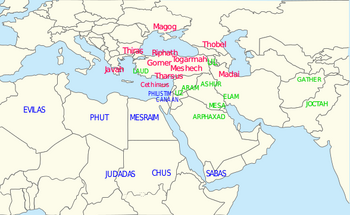- Grandson of Noah
- Progenitor of the Scythians and Scandinavians
Biography
Magog, son of Japheth, eldest son of Noah (Moses 8:12; see also Gen. 5:32; 6:10; 7:13; 9:18, 23). Japheth descendants were dispersed over the European coasts of the Mediterranean and the districts adjoining the Black and Caspian seas (Gen. 10:1–5, 21; 1 Chr. 1:4–5), forming what is now called the Indo-European family of nations.
Apocalyptic Traditions
Magog is often associated with apocalyptic traditions, mainly in connection with Ezekiel 38 and 39 which mentions "Gog of the land of Magog, the chief prince of Meshech and Tubal" (Ezek 38:2 NIV); on the basis of this mention, "Gog and Magog" over time became associated with each other as a pair. In the New Testament, this pairing is found in the Book of Revelation 20:8, in which instance they may merely be metaphors for archetypal enemies of God.
Progenitor of Scythians
Josephus refers to Magog son of Japheth as progenitor of Scythians, or peoples north of the Black Sea. According to him, the Greeks called Scythia Magogia (Ant., bk. I, 6). An alternate identification derived from an examination of the order in which tribal names are listed in Ezekiel 38, "would place Magog between Cappadocia and Media."
Johannes Magnus (1488–1544) stated that Magog migrated to Scandinavia (via Finland) 88 years after the flood, and that his five sons were Suenno (ancestor of the Swedes), Gethar (or Gog, ancestor of the Goths), Ubbo (who later ruled the Swedes and built Old Uppsala), Thor, and German. Magnus' accounts became accepted at the Swedish court for a long time, and even caused the dynastic numerals of the Swedish monarchs to be renumbered accordingly. Queen Christina of Sweden reckoned herself as number 249 in a list of kings going back to Magog. Magnus also influenced several later historians such as Daniel Juslenius (1676–1752), who derived the roots of the Finns from Magog.
Genesis Narrative
Japheth's descendants were dispersed over the European coasts of the Mediterranean and the districts adjoining the Black and Caspian seas (Gen. 10:1–5, 21; 1 Chr. 1:4–5), forming what is now called the Indo-European family of nations (Gentiles).
1 Now these are the generations of the sons of Noah, Shem, Ham, and Japheth: and unto them were sons born after the flood.
2 The sons of Japheth; Gomer, and Magog, and Madai, and Javan, and Tubal, and Meshech, and Tiras.
3 And the sons of Gomer; Ashkenaz, and Riphath, and Togarmah.
4 And the sons of Javan; Elishah, and Tarshish, Kittim, and Dodanim.
5 By these were the isles of the Gentiles divided in their lands; every one after his tongue, after their families, in their nations.
Historical Map

Geographic identifications for the Sons of Noah (Flavius Josephus, c. 100 AD); Japheth's sons shown in red
Siblings
| Name | Birth | Death | Joined with |
| Gomer ben Japheth | Mesopotamia | Mesopotamia | |
| Magog ben Japheth | Mesopotamia | Mesopotamia | |
| Madai ben Japheth | Mesopotamia | Mesopotamia | |
| Javan ben Japheth | Mesopotamia | Mesopotamia | |
| Tubal ben Japheth | Mesopotamia | Mesopotamia | |
| Meshech ben Japheth | Mesopotamia | Mesopotamia | |
| Tiras ben Japheth | Mesopotamia | Mesopotamia | |
References
- Book of Genesis 9-10
- 1 Chronicles 1:5-7
- Japheth - LDS Bible Dictionary
- Magog - Wikipedia
Footnotes (including sources)
| ||||||||||||||||||||